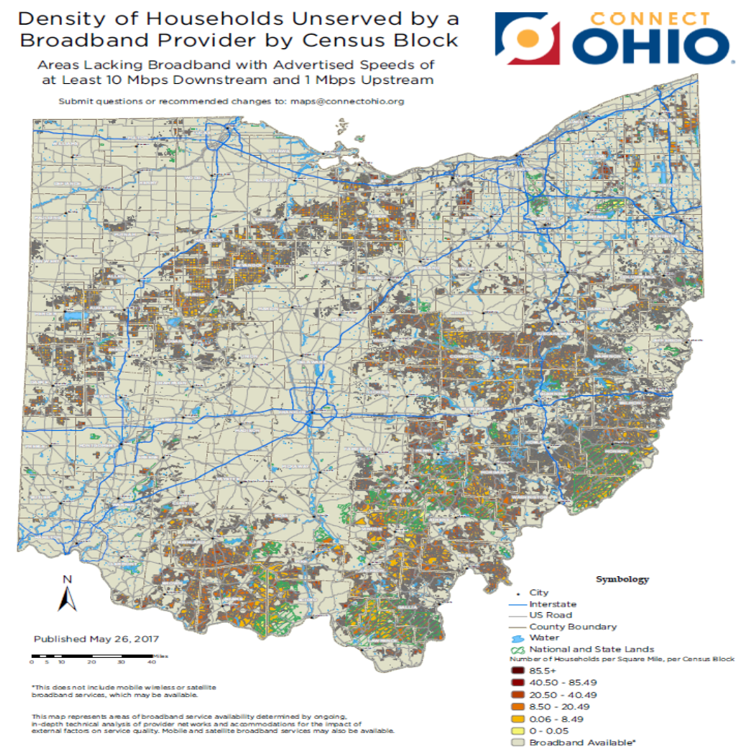The work from home revolution that COVID 19 is spreading could be a boon for communities who address quality of life issues but not unless they have adequate broadband to serve this digital revolution. Consumers and businesses are using their mobile devices more than ever before to connect to everyone and everything around them. As the map below illustrates, many Ohio communities, as elsewhere, face a daunting challenge with access to high-speed data networks that people and companies demand to live, work and play. Economists estimate the cost to provide a fiber optic network to underserved rural communities $61B.

A critical step to gaining more broadband access that should be eligible for ARPA funding is the creation of a broadband development strategic plan. Broadband strategic planning involves the measuring the area telecommunications service availability in a region reviewing potential last mile options, coordinating a needs assessment and community outreach to build a customer base for new broadband services, identification of projects and prioritization, outlining public-private-partnership models and advocating for local, state, and federal funding opportunities.
The American Rescue Plan Act (ARPA) provides billions of dollars for the development of broadband networks. ARPA provides local governments to gain $130.2 B divided evenly between non-county municipalities and counties with counties gaining $65.1 B in direct federal aid to all counties based on the county share of the U.S. population based on the most recent data available from the Census Bureau and non-county municipalities gaining $65.1 B with $45.57 B in direct federal aid for municipalities with populations of at least 50,000, using a modified Community Development Block Grant formula, and $19.53 B for municipalities with populations of less than 50,000 based on each jurisdiction’s percentage of the state’s population. This funding can be used to make necessary investments in water, sewer, or broadband infrastructure—all critical pieces to preparing sites for corporate site location projects.
ARPA also provides broadband education institution funding for E-Rate support for emergency educational connections and devices. ARPA provides nearly $7.2 B to create an Emergency Connectivity Fund to reimburse schools and libraries for internet access and connected devices for students and teachers learning remotely due to the pandemic; requires the FCC to issue rules within 60 days of enactment to provide funding to eligible schools and libraries to enable them to provide eligible connected devices, internet service and equipment necessary to support internet service to students and teachers, regardless of technology, for internet use in locations other than a school or library, among other things. ARPA also provides $10 B for states, territories, and tribal governments to carry out critical capital projects directly enabling work, education, and health monitoring, including remote options, in response to the public health emergency with respect to COVID-19. This funding is intended to be focused on broadband investment.
ARPA broadband funding is on top of the wide array of state and federal government broadband financing programs as listed below:
Ohio Broadband Funding. Ohio Governor Mike DeWine and legislative leaders have both proposed addressing the broadband challenge with funding estimated at $200M. No matter on the approach adopted, state of Ohio broadband funding is a likely source of revenue in 2021.
Federal Budget Earmarks. Discussion is underway in the Congress for the adoption again of the use of federal budget earmarks through the Congressional federal budget process which creates unique opportunities to gain broadband funding from a range of federal agencies through Congressional mandate lead by local members of the U.S. House of Representatives and U.S. Senate.
Power of the FCC Universal Service Fund. The Federal Communications Commission’s (FCC) Universal Service Fund (USF) distributes more than $7 B per year, primarily to address telecommunications access in rural America. Originally focused on providing cost-effective telephone services in remote locations, the USF has shifted to a focus on broadband and mobile service availability. The USF dwarfs all other past, present, or foreseeable future broadband funding programs at Federal, State or Local levels. USF should be a primary focus of any broadband funding strategy.
Rural Digital Opportunity Fund. The Federal Communications Commission’s (FCC) Rural Digital Opportunity Fund (RDOF) will distribute $20 B for rural broadband in the coming years. With Phase I completed in late 2020, the next efforts will focus on mapping which eligible block groups are awarded in Phase I and to whom. Comparative analysis of the block groups won versus the block groups not awarded will inform advocacy efforts for:
- Shaping RDOF Phase 2 rules,
- Informing Congressional action to modify both the rules and the funding levels for broadband infrastructure legislation and
- Educating potential bidders.
Rural 5G Fund. An additional $9 B will be allocated by the FCC in the Rural 5G Fund to close the mobility coverage gaps across the United States.
E-rate and Rural Health Care Programs. These two USF programs target K-12, libraries, and health care, with E-Rate allocations at $3.9 B per year and Rural Health Care at $800 M per year. These hefty funding allocations highlight why aggregation of demand among community anchor facilities can be so powerful in improving the availability of broadband.
ARPA tied to other local, state, and federal government funding sources should be able to make a dent in the development of needed broadband services; however, true solutions to the broadband dilemma will likely need public policy answers tied to customer subsidies so underserved telecommunication market customers can afford world class broadband services.